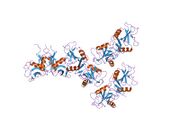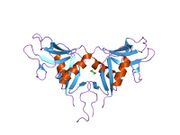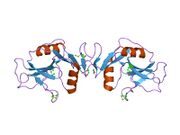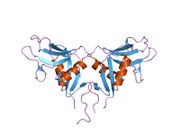Biology:OLR1
 Generic protein structure example |
Oxidized low-density lipoprotein receptor 1 (Ox-LDL receptor 1) also known as lectin-type oxidized LDL receptor 1 (LOX-1) is a protein that in humans is encoded by the OLR1 gene.[1][2]
LOX-1 is the main receptor for oxidized LDL on endothelial cells, macrophages, smooth muscle cells,[3] and other cell types.[4] But minimally oxidized LDL is more readily recognized by the TLR4 receptor, and highly oxidized LDL is more readily recognized by the CD36 receptor.[5]
Function
LOX-1 is a receptor protein which belongs to the C-type lectin superfamily. Its gene is regulated through the cyclic AMP signaling pathway. The protein binds, internalizes and degrades oxidized low-density lipoprotein.[citation needed]
Normally, LOX-1 expression on endothelial cells is low, but tumor necrosis factor alpha, oxidized LDL, blood vessel shear stress, and other atherosclerotic stimuli substantially increase LOX-1 expression.[4][6]
LOX-1 may be involved in the regulation of Fas-induced apoptosis. Oxidized LDL induces endothelial cell apoptosis through LOX-1 binding.[3] Other ligands for LOX-1 include oxidized high-density lipoprotein, advanced glycation end-products, platelets, and apoptotic cells.[3][6] The binding of platelets to LOX-1 causes a release of vasoconstrictive endothelin, which induces endothelial dysfunction.[6]
This protein may play a role as a scavenger receptor.[2]
Clinical significance
Binding of oxidized LDL to LOX-1 activates NF-κB, leading to monocyte adhesion to enthothelial cells (a pre-requisite for the macrophage foam cell formation of atherosclerosis).[4] Macrophage affinity for unmodified LDL particles is low, but is greatly increased when the LDL particles are oxidized.[7] LDL oxidation occurs in the sub-endothelial space, rather than in the circulation.[7] But oxidized cholesterol from foods cooked at high temperature can also be a source of oxysterols.[5]
Mutations of the OLR1 gene have been associated with atherosclerosis, risk of myocardial infarction, and may modify the risk of Alzheimer's disease.[2] When applied to human macrophage-derived foam cells in vitro, the dietary supplement berberine inhibits the expression of the ORL1 gene in response to oxidized low-density lipoprotein cholesterol,[8] but this has not yet been demonstrated in a living animal or human.[citation needed]
References
- ↑ "Assignment of the human oxidized low-density lipoprotein receptor gene (OLR1) to chromosome 12p13.1→p12.3, and identification of a polymorphic CA-repeat marker in the OLR1 gene". Cytogenet Cell Genet 82 (1–2): 34–6. Nov 1998. doi:10.1159/000015059. PMID 9763655.
- ↑ 2.0 2.1 2.2 "Entrez Gene: OLR1 oxidized low density lipoprotein (lectin-like) receptor 1". https://www.ncbi.nlm.nih.gov/sites/entrez?Db=gene&Cmd=ShowDetailView&TermToSearch=4973.
- ↑ 3.0 3.1 3.2 "LOX-1, OxLDL, and atherosclerosis". Mediators of Inflammation 2013: 1–12. 2013. doi:10.1155/2013/152786. PMID 23935243.
- ↑ 4.0 4.1 4.2 "LOX-1 in atherosclerosis: biological functions and pharmacological modifiers". Cellular and Molecular Life Sciences 70 (16): 2859–2872. 2013. doi:10.1007/s00018-012-1194-z. PMID 23124189.
- ↑ 5.0 5.1 "Current knowledge on the mechanism of atherosclerosis and pro-atherosclerotic properties of oxysterols". Lipids in Health and Disease 16 (1): 188. 2017. doi:10.1186/s12944-017-0579-2. PMID 28969682.
- ↑ 6.0 6.1 6.2 "A platelet-endothelium interaction mediated by lectin-like oxidized low-density lipoprotein receptor-1". Proceedings of the National Academy of Sciences of the United States of America 97 (1): 360–364. 2000. doi:10.1016/j.biochi.2016.10.010. PMID 10618423. Bibcode: 2000PNAS...97..360K.
- ↑ 7.0 7.1 "Antioxidative activity of high-density lipoprotein (HDL): Mechanistic insights into potential clinical benefit". BBA Clinical 8: 66–77. 2017. doi:10.1016/j.bbacli.2017.07.002. PMID 28936395.
- ↑ "Effects of berberine on expression of LOX-1 and SR-BI in human macrophage-derived foam cells induced by ox-LDL". Am J Chin Med 38 (6): 1161–9. 2010. doi:10.1142/s0192415x10008548. PMID 21061468.
Further reading
- Sawamura T (2002). "[Molecular identification of LOX-1 and analysis of its pathophysiological role]". Nippon Yakurigaku Zasshi 119 (3): 145–54. doi:10.1254/fpj.119.145. PMID 11915516.
- "Identification, regulation and function of a novel lectin-like oxidized low-density lipoprotein receptor". J. Am. Coll. Cardiol. 39 (9): 1429–35. 2002. doi:10.1016/S0735-1097(02)01803-X. PMID 11985903.
- Sawamura T (2002). "[LOX-1: the oxidized LDL receptor expressed in vascular endothelial cells]". Seikagaku 74 (5): 365–76. PMID 12073608.
- "Role of lectin-like oxidized low-density lipoprotein receptor-1 (LOX-1) in the development of hypertensive organ damage". Clin. Exp. Nephrol. 8 (3): 178–82. 2005. doi:10.1007/s10157-004-0288-9. PMID 15480893.
- "An endothelial receptor for oxidized low-density lipoprotein". Nature 386 (6620): 73–7. 1997. doi:10.1038/386073a0. PMID 9052782. Bibcode: 1997Natur.386...73S.
- "Identification of the lectin-like receptor for oxidized low-density lipoprotein in human macrophages and its potential role as a scavenger receptor". Biochem. J. 334 (Pt 1) (Pt 1): 9–13. 1998. doi:10.1042/bj3340009. PMID 9693095.
- "Identification and autoregulation of receptor for OX-LDL in cultured human coronary artery endothelial cells". Biochem. Biophys. Res. Commun. 248 (3): 511–4. 1998. doi:10.1006/bbrc.1998.9004. PMID 9703956.
- "The human gene encoding the lectin-type oxidized LDL receptor (OLR1) is a novel member of the natural killer gene complex with a unique expression profile". Genomics 54 (2): 191–9. 1999. doi:10.1006/geno.1998.5561. PMID 9828121.
- "Genomic organization and regulation of expression of the lectin-like oxidized low-density lipoprotein receptor (LOX-1) gene". J. Biol. Chem. 273 (50): 33702–7. 1999. doi:10.1074/jbc.273.50.33702. PMID 9837956.
- "The expression of the lectin-like oxidized low-density lipoprotein receptor (LOX-1) on human vascular smooth muscle cells and monocytes and its down-regulation by lovastatin". Biochem. Pharmacol. 57 (4): 383–6. 1999. doi:10.1016/S0006-2952(98)00313-X. PMID 9933026.
- "Structure and chromosomal assignment of the human lectin-like oxidized low-density-lipoprotein receptor-1 (LOX-1) gene". Biochem. J. 339 (Pt 1) (Pt 1): 177–84. 1999. doi:10.1042/0264-6021:3390177. PMID 10085242.
- "Upregulation of endothelial receptor for oxidized low-density lipoprotein (LOX-1) in cultured human coronary artery endothelial cells by angiotensin II type 1 receptor activation". Circ. Res. 84 (9): 1043–9. 1999. doi:10.1161/01.res.84.9.1043. PMID 10325241.
- "Expression of lectinlike oxidized low-density lipoprotein receptor-1 in human atherosclerotic lesions". Circulation 99 (24): 3110–7. 1999. doi:10.1161/01.cir.99.24.3110. PMID 10377073.
- "Oxidized LDL upregulates angiotensin II type 1 receptor expression in cultured human coronary artery endothelial cells: the potential role of transcription factor NF-kappaB". Circulation 102 (16): 1970–6. 2000. doi:10.1161/01.cir.102.16.1970. PMID 11034947.
- "The centromeric part of the human NK gene complex: linkage of LOX-1 and LY49L with the CD94/NKG2 region". Genes Immun. 1 (4): 280–7. 2001. doi:10.1038/sj.gene.6363678. PMID 11196705.
- "Characterization of residues and sequences of the carbohydrate recognition domain required for cell surface localization and ligand binding of human lectin-like oxidized LDL receptor". J. Cell Sci. 114 (Pt 7): 1273–82. 2001. doi:10.1242/jcs.114.7.1273. PMID 11256994.
- "Conserved C-terminal residues within the lectin-like domain of LOX-1 are essential for oxidized low-density-lipoprotein binding". Biochem. J. 355 (Pt 2): 289–96. 2001. doi:10.1042/0264-6021:3550289. PMID 11284714.
- "Histamine increases the expression of LOX-1 via H2 receptor in human monocytic THP-1 cells". FEBS Lett. 508 (3): 345–9. 2001. doi:10.1016/S0014-5793(01)03073-3. PMID 11728449.
- "A novel cluster of lectin-like receptor genes expressed in monocytic, dendritic and endothelial cells maps close to the NK receptor genes in the human NK gene complex". Eur. J. Immunol. 31 (12): 3493–503. 2002. doi:10.1002/1521-4141(200112)31:12<3493::AID-IMMU3493>3.0.CO;2-9. PMID 11745369.






